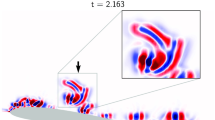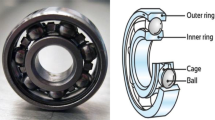Abstract
The fast spectrum kurtosis (FSK) algorithm can adaptively identify resonance bands of a signal, and fault characteristics can be extracted by analyzing the selected frequency bands. However, in practical applications, the bearing failure may be composed of various faults (inner ring/outer ring/rolling element) and the faults may be located in different resonant bands. Due to the interference between different fault components and noise, the weak components may be submerged when FSK is used to deal with compound fault signals. To improve the accuracy of an FSK processing compound fault located in different resonance bands, an improved FSK method combined with the variational mode decomposition (VMD) is proposed. First, the parameters (number of components K / penalty factor α ) in the VMD decomposition are selected, and the original compound fault signal is preprocessed by VMD decomposition, so that the original signal is decomposed into K variational intrinsic mode function (VIMF) components. The resonance center bands of these signals are different from each other, so the different fault information is located in different VIMF. Finally, each VIMF component is calculated by FSK. Through the simulated and experimental analysis, the method can accurately identify the resonance bands, and identify the weak fault characteristics of compound bearing fault.
Similar content being viewed by others
References
R. B. Randall and J. Antoni, Rolling element bearing diagnostics— A tutorial, Mechanical Systems and Signal Processing, 25 (2) (2011) 485–520.
M. S. Patil, J. Mathew and P. K. RajendraKumar, Bearing signature analysis as a medium for fault detection: A review, J. of Tribology, 130 (1) (2008) 014001.
J. Zhang, D. Huang, J. Yang, H. Liu and X. Liu, Realizing the empirical mode decomposition by the adaptive stochastic resonance in a new periodical model and its application in bearing fault diagnosis, J. of Mechanical Science and Technology, 31 (10) (2017) 4599–4610.
G. Tang, X. Wang and Y. He, Diagnosis of compound faults of rolling bearings through adaptive maximum correlated kurtosis deconvolution, J. of Mechanical Science and Technology, 30 (1) (2016) 43–54.
S. Jin and S.–K. Lee, Bearing fault detection utilizing group delay and the Hilbert–Huang transform, J. of Mechanical Science and Technology, 31 (3) (2017) 1089–1096.
J. Antoni, The spectral kurtosis: A useful tool for characterising non–stationary signals, Mechanical Systems and Signal Processing, 20 (2) (2006) 282–307.
J. Antoni and R. B. Randall, The spectral kurtosis: application to the vibratory surveillance and diagnostics of rotating machines, Mechanical Systems and Signal Processing, 20 (2) (2006) 308–331.
J. Antoni, Fast computation of the kurtogram for the detection of transient faults, Mechanical Systems and Signal Processing, 21 (1) (2007) 108–124.
Y. Lei, J. Lin, Z. He and Y. Zi, Application of an improved kurtogram method for fault diagnosis of rolling element bearings, Mechanical Systems and Signal Processing, 25 (5) (2011) 1738–1749.
D. Wang, P. W. Tse and K. L. Tsui, An enhanced Kurtogram method for fault diagnosis of rolling element bearings, Mechanical Systems and Signal Processing, 35 (1–2) (2013) 176–199.
X. Xu, M. Zhao, J. Lin and Y. Lei, Periodicity–based kurtogram for random impulse resistance, Measurement Science and Technology, 26 (8) (2015) 085011.
T. Wang, Q. Han, F. Chu and Z. Feng, A new SKRgram based demodulation technique for planet bearing fault detection, J. of Sound and Vibration, 385 (12) (2016) 330–349.
Y. Miao, M. Zhao and J. Lin, Improvement of kurtosisguided–grams via Gini index for bearing fault feature identification, Measurement Science and Technology, 28 (12) (2017) 125001.
J. Antoni, The infogram: Entropic evidence of the signature of repetitive transients, Mechanical Systems and Signal Processing, 74 (6) (2016) 73–94.
D. Konstantin and Z. Dominique, Variational mode decomposition, IEEE Transactions on Signal Processing, 62 (3) (2014) 531–544.
Y. Wang, R. Markert, J. Xiang and W. Zheng, Research on variational mode decomposition and its application in detecting rub–impact fault of the rotor system, Mechanical Systems and Signal Processing, 60–61 (8) (2015) 243–251.
S. Zhang, Y. Wang, S. He and Z. Jiang, Bearing fault diagnosis based on variational mode decomposition and total variation denoising, Measurement Science and Technology, 27 (7) (2016) 075101.
X. Zhang, Q. Miao, H. Zhang and L. Wang, A parameteradaptive VMD method based on grasshopper optimization algorithm to analyze vibration signals from rotating machinery, Mechanical Systems and Signal Processing, 108 (8) (2018) 58–72.
H. Yang, S. Liu and H. Zhang, Adaptive estimation of VMD modes number based on cross correlation coefficient, J. of Vibroengineering, 19 (2) (2017) 1185–1196.
Z. Lv, B. Tang, Y. Zhou and C. Zhou, A novel method for mechanical fault diagnosis based on variational mode decomposition and multikernel support vector machine, Shock and Vibration, 2016 (2016) 1–11.
S. Wan, X. Zhang and L. Dou, Compound fault diagnosis of bearings using an improved spectral kurtosis by MCDK, Mathematical Problems in Engineering, 2018 (2018) 1–12.
Y. Cheng, N. Zhou, W. Zhang and Z. Wang, Application of an improved minimum entropy deconvolution method for railway rolling element bearing fault diagnosis, J. of Sound and Vibration, 425 (7) (2018) 53–69.
Author information
Authors and Affiliations
Corresponding author
Additional information
Recommended by Associate Editor Gyuhae Park
Shuting Wan is a Professor at the School of Mechanical Engineering in North China Electric Power University. He obtained his Ph.D. from the North China Electric Power University, China, in 2006. His research interests include condition monitoring and fault diagnosis of power equipment.
Xiong Zhang is a Ph.D. student at the School of Mechanical Engineering in North China Electric Power University. His research interest is condition monitoring and fault diagnosis of power equipment.
Longjiang Dou is a Ph.D. student at the School of Mechanical Engineering in North China Electric Power University. His research interest is condition monitoring and fault diagnosis of power equipment.
Rights and permissions
About this article
Cite this article
Wan, S., Zhang, X. & Dou, L. Compound fault diagnosis of bearings using improved fast spectral kurtosis with VMD. J Mech Sci Technol 32, 5189–5199 (2018). https://doi.org/10.1007/s12206-018-1017-8
Received:
Revised:
Accepted:
Published:
Issue Date:
DOI: https://doi.org/10.1007/s12206-018-1017-8




